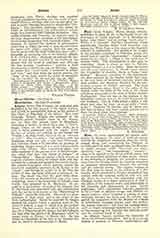

Aeons, the term appropriated by Gnostic heresiarchs to designate the series of spiritual powers evolved by progressive emanation from the divine eternal Being, and constituting the Pleroma, or invisible spiritual world, as distinct from the Kenoma, or visible material world. The word aeon (aion), signifying “age”, “the ever-existing”, “eternity” came to be applied to the divine eternal power, and to the personified attributes of that power, whence it was extended to designate the successive emanations from the divinity which the Gnostics conceived as necessary intermediaries between the spiritual and the material worlds. The Gnostic concept of the “Eon may be traced to the influence of a philosophy which postulated a divinity incapable of any contact with the material world or with evil, and the desire to reconcile this philosophy with the Christian notion of a direct interference of God in the affairs of the material world, and particularly in the Creation and Redemption of man. Jewish angelology, which represented Jehovah ministered to by a court of celestial beings, and Hellenic religious systems, which imagined a number of intermediaries between the finite and the infinite, suggested the emanation from the divinity of a series of subordinate heavenly powers, each less perfect, the further removed it was from the supreme deity, until at length increasing imperfection would serve as the connecting link between the spiritual world and the material world of evil.
In different Gnostic systems the hierarchy of Aeons was diversely elaborated. But in all are recognizable a mixture of Platonic, mythological, and Christian elements. There is always the primitive all-perfect Aeon, the fountainhead of divinity, and a coeternal companion Aeon. From these emanate a second pair who, in turn, engender others, generally in pairs, or in groups of pairs, in keeping with the Egyptian idea of divine couples. One of these inferior ‘Eons, desiring to know the unknowable, to penetrate the secrets of the primal .Eon, brings disorder into the Aeon-world, is exiled, and brings forth a very imperfect Aeon, who, being unworthy of a place in the Pleroma, brings the divine spark to the nether world. Then follows the creation of the material universe. Finally, there is evolved the Aeon Christ, who is to restore harmony in the Aeon-world, and heal the disorder in the material world consequent upon the catastrophe in the ideal order, by giving to man the knowledge which will rescue him from the dominion of matter and evil. The number of Aeons varies with different systems, being determined in some by Pythagorean and Platonic ideas on the mystic efficacy of numbers; in others by epochs in, or the duration of, the life of Christ. The Aeons were given names, each Gnostic system having its own catalogue, suggested by Christian terminology, and by Oriental, or philosophical and mythological nomenclature. There were nearly as many aeonic hierarchies as there were Gnostic systems, but the most elaborate of these, as far as is known, was that of Valentinus, whose fusion of Christianity and Platonism is so completely described in the refutation of this system by St. Irenaeus and Tertullian. (See Gnosticism, Valentinus and Valentinians, Basilides, Ptolemy the Gnostic.)
JOHN B. PETERSON

